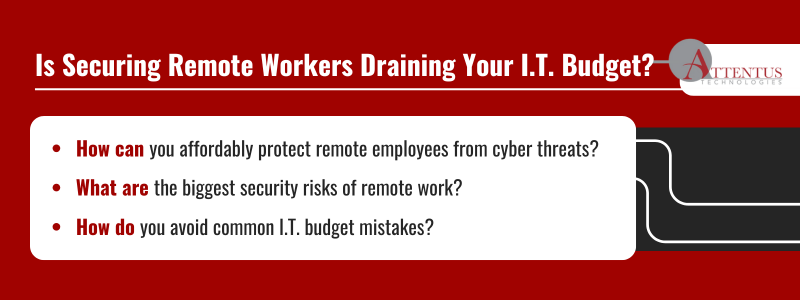Balancing security and cost for remote workforces doesn’t have to break the bank. Here’s how to secure your team and stay on budget.

Remote work is one of the lingering effects of the COVID-19 pandemic, with many organizations embracing hybrid and remote workforces as cost-effective and productive ways to do business.
While remote work offers many benefits, organizations must also find ways to secure remote workers without driving up I.T. costs. Some business leaders mistakenly believe that remote solutions inevitably come with exorbitant I.T. expenses.
So here is how you can achieve the delicate balance of optimizing your I.T. budget while providing effective cybersecurity for remote employees.
What Are the Real Risks of Remote Work?
Off-site work does, undoubtedly, come with cybersecurity challenges that cannot be ignored by any safety-minded organization.
Some of the hidden dangers of remote work include:
- Increased vulnerability to social engineering, phishing, and other cyber threats
- Multiple remote devices and access points that provide opportunities for hackers
- Security holes caused by a lack of system/software updates
- Lack of planning, which leads to slow response times
- Use of insecure public Wi-Fi
- Not enough worker education
- Weak passwords
- Use of workers’ personal devices
Unaddressed, these risks can lead to costly breaches. Establishing a centralized, cloud-based environment with built-in security can simplify data management and help keep your business safe.
Costly Mistakes to Avoid in Remote Security
Of course, many solutions are available to businesses looking to secure remote workers while trying to achieve I.T. budget optimization. But they all cost money and can consume a significant part of your I.T. resources if not properly selected and managed.
So, as a business owner, you must decide if overinvesting in a complex, costly solution matches your remote security needs. Are there cost-effective measures, such as training and policy enforcement, that can give you the safety and security you need?
The answer is often yes.
Cost-effective strategies to secure remote workers
In truth, organizations don’t have to sacrifice cybersecurity in order to enjoy the benefits of a remote or hybrid workforce. Sound safety strategies include:
- Implementing affordable, scalable virtual private networks (VPNs) for off-site work
- Enabling multi-factor authentication
- Keeping system patches and upgrades up to date
- Limiting staff access to critical data
- Establishing layered security services
- Using an effective management system for remote devices
- Employing password managers
- Doing regular data backups
- Deploying secure web gateways
- Adopting cloud-based solutions with built-in security features
Workers at home, and indeed all workers, should have ready access to safety and procedure policies and undergo formal training in security and awareness via videoconferencing. The training should be held regularly, with a special emergency session held if a threat is detected or to deconstruct, and learn from, a response to one.
You should also establish sound work-from-home (WFH) policies and conduct regular operational reviews to see how you can improve security measures further. It’s also a good idea to leverage the services of a trusted managed services provider (MSP) to handle security and monitoring for abuses and threats.
They can provide remote I.T. services that identify threats and problems before they arise and resolve them early. Continuous service ensures that your essential I.T. systems and applications are always up and running and that expert technicians resolve any challenges quickly and accurately.
Maximize Your Budget with Predictable, Fixed Pricing
To maintain a secure and cost-effective I.T. environment, it’s critical to identify solutions that provide maximum security while staying within your financial limits. A fixed pricing model offers businesses a reliable way to manage their I.T. budgets with predictable monthly costs.
This approach covers essential services like cybersecurity, proactive monitoring, network management, and lifecycle planning, ensuring your systems are secure and optimized without the fear of unexpected expenses. By adopting a fixed pricing plan, you gain the advantage of consistent billing while maintaining access to scalable and effective I.T. solutions.
Tailored to your company’s size and specific requirements, a fixed pricing model can eliminate budget uncertainty and help you focus on growth while keeping security a top priority. You can protect your remote workforce and critical systems without sacrificing financial control or the quality of your I.T. services.
Budget-friendly remote workers’ solutions
Effectively managing remote workforces while ensuring security can be challenging, particularly regarding budget. Understanding the risks involved and identifying targeted, cost-effective solutions is essential—simply increasing spending isn’t the answer.
Attentus Technologies offers proven solutions with fixed pricing that help you optimize your I.T. budget without compromising on security. From multi-factor authentication to staff training, we tailor our security measures to meet your specific needs.
At Attentus, ‘be the answer’ is more than just a motto—it’s a core value we live by every day. We don’t just deliver services; we take full ownership of every I.T. challenge, ensuring we’re the solution you can depend on. Let us help you transform your remote workforce into a valuable asset.
Contact us today for a consultation and learn how our tailored I.T. solutions can support your business!

